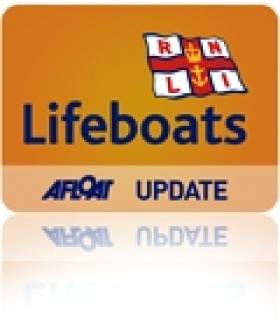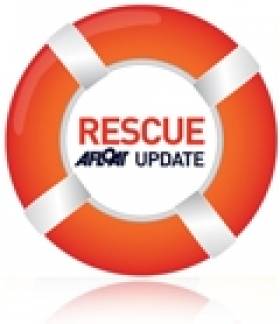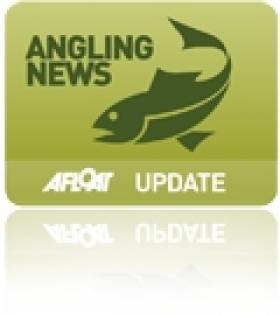Displaying items by tag: Lough Ree
Lough Ree RNLI To Celebrate First Year of Service
#RNLI - Lough Ree RNLI is celebrating its first year in service and is holding an open day on Saturday 31 August for the public to come and see how the station operates.
The volunteer crew at the station will be on hand to meet and greet people as well as put on a display to show how the inshore lifeboat is launched, some of the exercises it carries out and how it is then recovered.
Lough Ree RNLI lifeboat station in Co Westmeath went into operation on a trial period in July last year and since then has been a busy station, with 14 call-outs in its first six months of operation and a further 24 shouts to date in 2013.
The call-outs have been varied from helping boats that have got into difficulty in rough weather, to helping vessels which have got lost while on the lake day and night, to a boat sinking rapidly after hitting hidden debris in the water.
All RNLI lifeboat stations are run on a volunteer basis and it is through the time and dedication shown by their volunteer crew members that they are able to provide communities, including Lough Ree's, with such a vital search and rescue service.
All at Lough Ree RNLI are looking forward to meeting visitors at the station in Coosan Point on Saturday 31 August between 2pm and 4pm.
Round Ireland Record – The New Inside Story
#rioti – The further west you go in Ireland, the more it all seems like a giant theatre set. With giant characters to match. We staid East Coast folk could probably cope with it if each of these outsize characters, who aren't necessarily physically large, confined themselves to just one OTT role. But they act out dozens of melodramatic parts. Each individual is a one-man or one-woman cast of thousands. And they've multiple crazy ideas to match.
Plus it's all set in a context where time is meaningless, or at least time is whatever you think it might be, communication seems to be by telepathy, and anything is written down only for the purposes of ignoring it.
In sailing, this western way comes suddenly upon you when you set forth with hope in your heart for an event on the Shannon. I don't mean one of those official events which have proper programmes, and are staged as regional, national or international championships for one design classes, and everything is done according to plan. I mean the quirkier happenings which stem from the nature of the great river and its magnificent lakes, and the unique possibilities which its myriad waters offer for event inventors and organisers whose soaring imaginations tend to out-strip their interest in the tedious nitty-gritty of putting a complex sailing programme together, and particularly of publicising it for those who might be interested in taking part. They tend to suppose that their pet notion is a thing of such beauty that it will acquire its own organisational and promotional impetus. As this becomes apparent, you can only think that the longest river in Britain and Ireland must have come within an ace of being named the River Shambles.
Thus on Thursday on Shannon waters we found ourselves sailing past Rockall. As one does of a Thursday. Or at least one does on Lough Ree. Down there, plumb in the middle of Ireland where they've had a sailing club of some sort in existence since 1770, they've been toying for years with the idea of staging a Round Ireland On The Inside Race, a sort of inverted compliment to Wicklow SC's biennial classic round the outside, as the Lough Ree course planned to go "inside Ireland and all her islands".
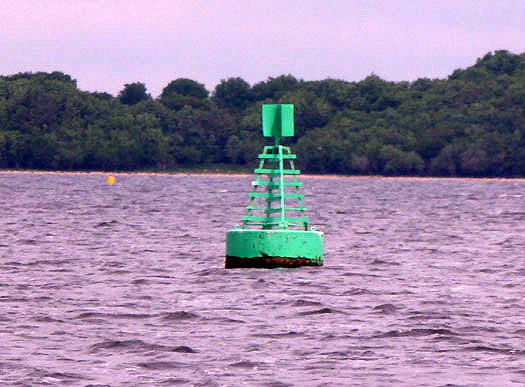
The buoy marking the Adelaide Rock in Lough Ree became Rockall-for-the-Day. Photo: W M Nixon
The two bright boys who have worked up the notion are David Beattie, owner of the 47ft Dutch sailing Lemsteraak Schollevaer, and Lough Ree YC Commodore Alan Algeo, who owns the 84ft Dutch motor barge Linquenda. As both boats had their centenary coming up in 2013, this was to be the year, and I had signed on for a day or three aboard Schollevaer, as the RIOTI event would be in the midst of agreeable cruises-in-company to the many watering holes around Lough Ree.
Unfortunately, the big freeze of a couple of winters ago put paid to Schollevaer's participation, as the ice burst a seacock (and no, I don't know why it's called a seacock on a lake either), and her major refurbishment subsequent to immersion, while almost completed, was going to miss the due date. So no Schollevaer. But not to worry they said, just turn up and we'll find you a berth.
So we drove west through a belt of rain which was lifting to promise a classic day of Irish Atlantic weather and a nice westerly sailing breeze to match, and arrived at Ballyglass to find Lough Ree's fine premises a hive of inactivity. Race Officer Beattie was aboard his other boat, the Shipman 28 Aeolus, looking quite the part in a yachting cap of a type I thought had disappeared after the Hitler Unpleasantness, while contemplating with Buddha-like stillness an array of signal flags which would have been more than adequate for Belfast on a sunny Twelfth of July. But of the Commodore there was no sign whatever. It emerged he was deep in the bilges of Linquenda, sorting a problem with a pump which had been proving inadequate to prevent his ship becoming the second centenarian barge to settle on the bed of Lough Ree within two years.
As for dozens of enthusiastic yachties mustard keen to take on this great challenge of a new Round Ireland Record (Inside Department), there was scarcely a sinner about the place, keen or otherwise. But that's how it is down the Shannon. Eventually it all comes together, and everyone has a great bit of sport. But in a region where the usual dinner arrangement is 8 o'clock for midnight, there's no point in expecting anything that resembles International Standard Time.

Commodore Alan Algeo, having sorted the bilge pump to keep the Commodorial barge afloat for another day, attends to domestic duties in Linquenda's large multi-purpose cabin. Photo: W M Nixon
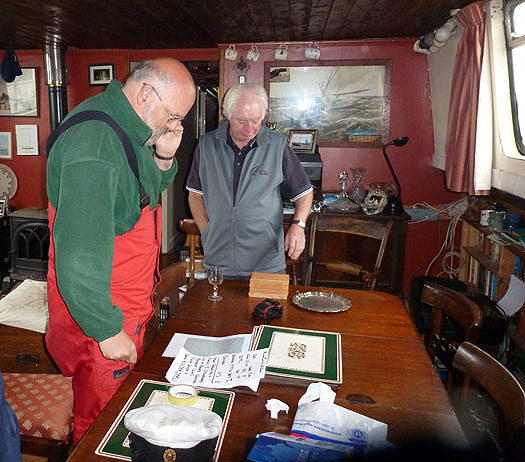
Aboard Linquenda at the saloon table (a family heirloom), Race Officer David Beattie considers course options. Photo: W M Nixon
Eventually the Commodore emerged from a successful interview with Linquenda's bilge pump, and went about his domestic duties in the vast main cabin. There, we were soon joined by the Race Officer who then went through the options and finalised a course. Initial high flown ideas of laying special new marks in order to replicate Ireland's islands and headlands had been long since abandoned, and we made do with navigation buoys and Lough Ree YC's more-than-adequate system of racing marks across the southern half of the lake, the only real adherence to the original idealism being that the starting line in at Hare Island should be in line with the bearing from Wicklow Head. We were also told that with a clockwise course, we'd be leaving the navigational buoys marking the Adelaide Rock to starboard, and that for the purposes of this event the Adelaide Rock would be re-named Rockall.
Apart from it being politically contentious as to just who – if any – has a right to claim Rockall as national territory, this meant that we would be going outside Rockall-for-the-Day, when all the talk had been about going inside Ireland and all her islands. Then too, a worthwhile course meant we went round – in other words outside – gallant little Beam Island in the south end of the lake. But on this being pointed out, it was airily dismissed on the grounds that among Lough Ree sailors, Beam Island is regarded as The Actual Centre Of Ireland, so even a race going round the inside would just have to go round the outside of Beam island. Simple, really.
The course was a coastal circuit of the southern part of Lough Ree, starting and finishing at Hare Island on a line set on the bearing from Wicklow Head, with Beam Island the only island enclosed by a course which otherwise went "inside Ireland and all her islands".
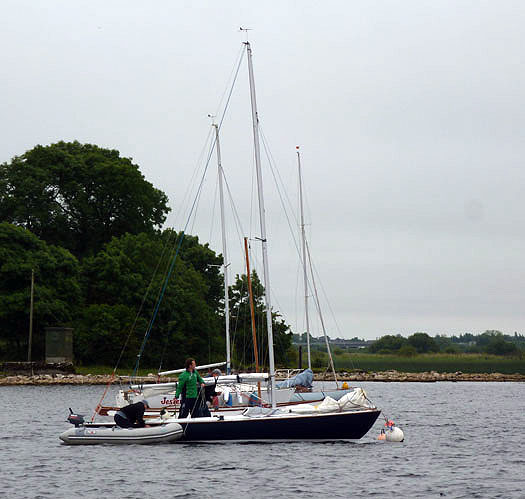
The hot contender – Philip Watson's very souped-up Ajax 23 Pathfinder on her mooring at LRYC Photo: W M Nixon

The Race Officer geared for action in full dress uniform Photo: W M Nixon
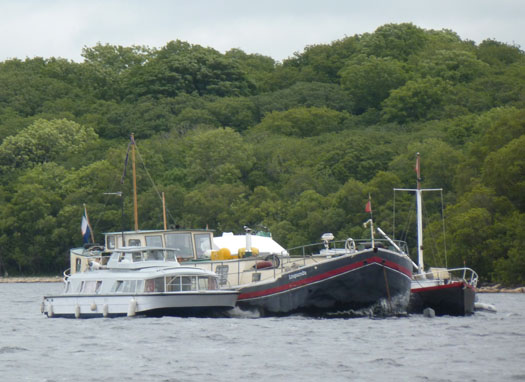
Spectator boats and motherships centred on Linquenda Photo: W M Nixon
The fleet taking on this challenge for the first time made up in quality and variety anything it lacked in numbers. The star turn was undoubtedly Cathy MacAleavey, one of the Lakota crew whose Round Ireland Record (Outside Section) of 1993 still stands after all the faffing about by the MOD 70s in Dublin Bay last weekend. But far from taking on the inside record with some fancy multi-hull, as the start time (whatever it might eventually be) was approaching, Cathy was sailing down the lake from Lecarrow to compete with the classic Water Wag which she built with the tutelage of the great Jimmy Furey at that remote Roscommon port.
The Shannon One Designs were also making a pitch, and from the deep south and the mysterious and mountainous coasts of Lough Derg had come Reggie Goodbody with his elegant gaff sloop Amaryllis as mother ship for his impossibly superb Shannon OD, complete with million carat gold cove line. As for the white-hot keelboat division, elapsed time favourite had to be Philip Watson crewed by Roger Cagney with the Ajax 23 Pathfinder, which he has souped up in such style that you'd scarcely recognise her as the Squib's big sister - he even sets a masthead genniker which certainly puts the cat among the Three Jolly Pigeons down on the coast of the Goldsmith country.
It was in the cruisers I found myself a berth. John Banim was planning to put in a show with his Evasion 29 La Reveuse crewed only by his lakedog Rex, but it was decided Rex could sail as passenger, and we'd challenge for the Cruisers Two-Handed Division. It was a shrewd career move, as no other cruiser had only two men and a dog aboard. And this was one interesting cruiser. Most folk would think she's only a glorified motor-sailer, but back in 1980 Andre Beneteau designed, and his family firm built, this 29-footer which really does sail, yet provides accommodation to commodious motor-boat standard, with a comfortable dining area where the windows are so arranged that you can see out without having to stand up, which is not always the case with fancy deck saloons.

John Banim's Evasion 29 La Reveuse was the only boat in RIOTI which had also sailed round Ireland on the outside. Photo: W M Nixon
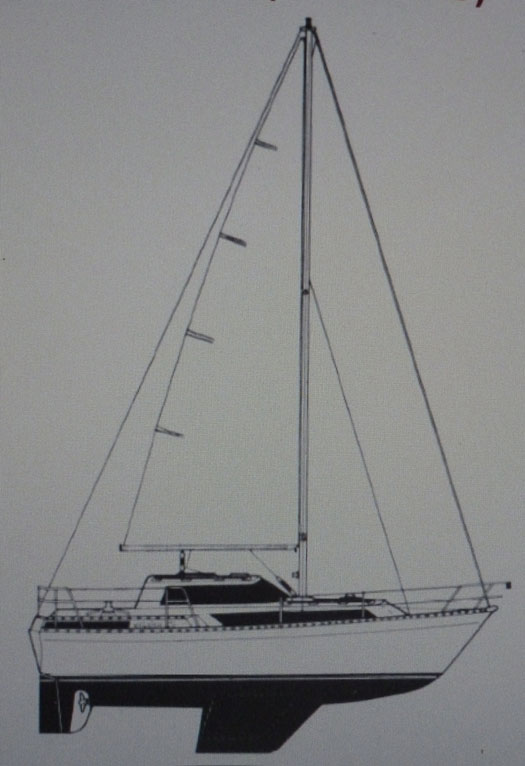
The Andre Beneteau-designed Evasion 29 is a motor-sailer which really can sail

The accommodation on La Reveuse is extremely good for a boat of this size
There are dual steering positions, and thanks to extensive windows and decklights, you really can sail the boat from below, the only drawback being that the cockpit's tiller steering and the saloon's wheel steering cannot be de-coupled from each other, which makes the tiller steering seem much heavier than it really is, though the powerful wheel is fine. That said, for family use you'd wonder at the safety of having a tiller and steering wheel which can suddenly turn when the other method is being used – children might get caught up in it, but it hasn't been a problem this far.
As for seagoing ability, La Reveuse proved herself with a round Ireland cruise – starting and finishing at Kilrush in the Shannon Estuary - in 2002. She experienced some rough weather, particularly on a passage from west Mayo to Killybegs, yet John and his crew never felt that the big coachroof and extensive windows were at risk. And thanks to that cruise, this was the only boat taking on the RIOTI challenge which had also sailed round on the outside.
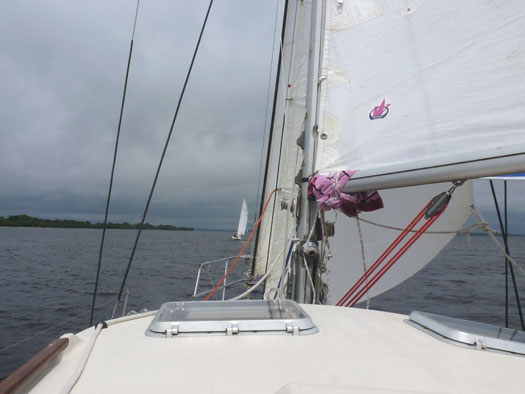
In the early stages of grey weather sailing, Ventus (with Pathfinder even more distant) seemed to be building up an unassailable lead on La Reveuse. Photo: W M Nixon
As for the course, using the LRYC marks and some navigation buoys it was simply a coastal circuit right round the lower part of the lake, staying south of Nun's Island, with only Beam island consigned to the inner darkness. With the rain well cleared to the east, the breeze piped up from the west, and though it slackened at mid-afternoon in grey conditions, it soon came back brisk and fresh with sunshine to provide great sailing, with Lough Ree and its vast skies at their summertime best.

Lakedog Rex wasn't too sure he liked this racing business, but with the skipper busy on the helm, he was able to enjoy the usually off-limits comfort of the best settee berth. Photo: W M Nixon
It was no surprise that Pathfinder did a horizon job on the rest of us, but as we were later to discover, she'd a handicap so punitive she'd have had to finish almost before the rest of us had started if she was going to win on corrected time. Aboard Le Reveuse, we'd resigned ourselves to crossing the finish line third, as Pat Mahon's GRP Folkboat Ventus worked ahead – particularly to windward – in the first of the two rounds. But as we got to the bottom end of the lake for the second circuit, the breeze freshened and blew away the clouds, and our gallant little tubby cruiser settled to her work in the sunshine, and powered northward on a close fetch along the Roscommon shore to such good effect that as we were passing Rockall-for-the-Day for the second time, La Reveuse was dumping on Ventus, and we rounded the furthest turn at the Cribby Islands buoy a whisker ahead.

Final leg southward down the Westmeath shore. Once he'd got through Pat Mahon's Folkboat Ventus.................
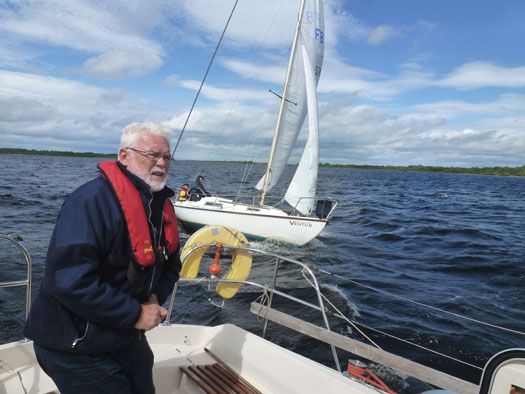
............skipper John Banim was very determined to stay ahead. Photos: W M Nixon
La Reveuse managed to hang onto it – though only just - through a brisk run and reach back to the finish. The line crossed, Rex on his settee berth below could sense the easing of tension, and bounded out into the cockpit to find the new RIOTI Two-Handed Cruiser Champions high-fiving with exuburance.
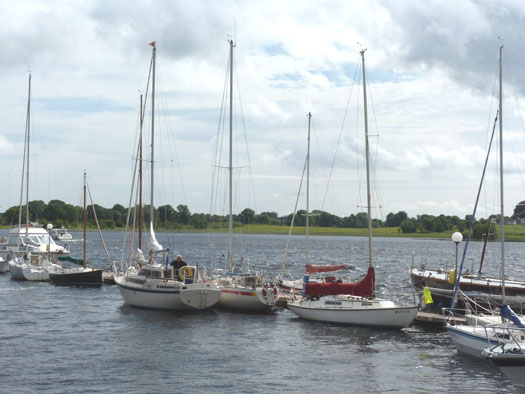
Summer evening post-race at Lough Ree YC Photo: W M Nixon
The classes had got well strung out, and we'd been busy enough with our own work without trying to pay attention to the dinghies, but it was clear that one of the Shannons had sailed a mighty race, and it was Frank Browne of Portlaw in County Waterford who won by a country mile, while in the Water Wags, Ian Malcolm of Howth managed to finish ahead of Cathy McAleavey.
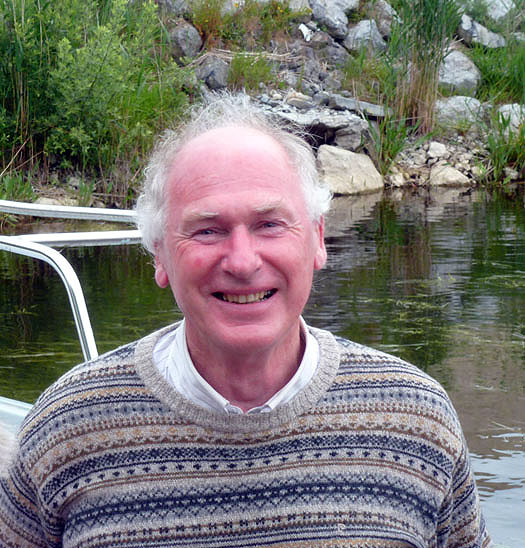
Frank Browne had a mighty win in the Shannon One Designs Photo: W M Nixon
It may have seemed a bit chaotic beforehand, but in the best Shannon traditions it all came together, and we even had an official set of results well before sunset. They were:
RIOTI 2013
Keelboats & Cruisers: lst Ventus (Folkboat, Pat Mahon) CT 2hrs 11mins 44 secs; 2nd La Reveuse (Evasion 29, John Banim) 2hrs 15mins 6secs; 3rd Pathfinder (Ajax 23, Philip Watson) 2hrs 21mins 13secs
Shannon ODs: 1st No 86 (Frank Browne); 2nd No 138 (Alan Algeo); 3rd No 58 (Daphne Shackleton).
Water Wags: 1st No 8 (Ian Malcolm), 2nd No 41 (Cathy McAleavy).
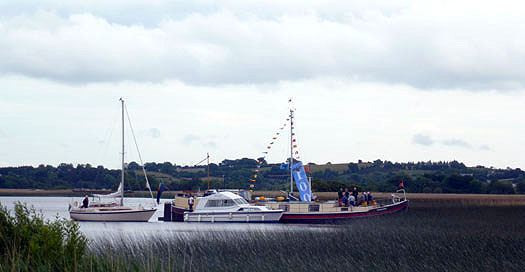
Linquenda and friends ensconced in the reeds to begin her Centenary Party in Killinure Lake Photo; W M Nixon

Rachel Leech's much-travelled Ebenhaezer – recently returned via the Grand Canal from the Old Gaffers Association Golden Jubilee in Dublin – joined the Linquenda RIOTI party at Glasson Hotel. Photo: W M Nixon
The racing disposed of, the fleet re-convened along with Rachel Leech's much-travelled 64ft Dutch barge Ebenhaezer in one of the sweetest places on the Shannon, the little harbour in the northern end of Killinure Lake at Glasson Hotel & Country Club. It's ironic that this idyllic spot is at an establishment which majors in golf. But it provided a sumptuous Linquenda Centenary Dinner, and appropriate celebration for the establishment of the first Round Ireland On The Inside Record, which is held by Philip Watson and Roger Cagney regardless of where they might have finished with Pathfinder on handicap.
This weekend, the inland waterways racing is back in the numbers game in every way, with the annual Long Distance Race in two stages today and tomorrow, down the Shannon from Lough Ree to Lough Derg. Then the next major happenings are the traditional regatta weeks on Derg and Ree, while the Shannon One Designs have other events on their calendar including an outing to Lough Corrib, which some would argue is the most beautiful lake of all.
With so much going on, you can see why it was so difficult to fit a new event like RIOTI into the programme. So whether or not it will happen again is anybody's guess. Maybe it would be better just to remember it as one stand-alone perfect day's sailing. For RIOTI 2013 was that and more.

Shannon ODs looking more beautiful than ever at Glasson Photo: W M Nixon
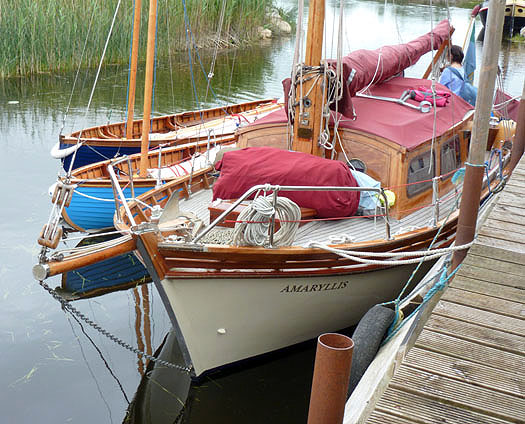
Reggie Goodbody's characterful Amaryllis from Lough Derg will be returning home to Dromineer this weekend after the long distance race down from Lough Ree. Photo: W M Nixon
RNLI Lifeboats Have Busy June Bank Holiday Weekend
#RNLI - It was a busy June bank holiday weekend around the country for RNLI lifeboats in West Cork, Mayo and the Midlands.
On Sunday afternoon, Baltimore RNLI assisted four people after their yacht got into difficulty a mile south of Mizen Head.
The 32ft yacht with four people on board had been propped by a pot buoy immobilising her in the water. The alarm was raised at 10.41am and lifeboat the Alan Massey was launched minutes later.
A local RIB, which had commenced towing, passed the tow to the lifeboat and the yacht was then taken to the safety of Crookhaven Pier.
This was the second call out this week for Baltimore RNLI. On Thursday last three men were rescued when their punt overturned near Horse Island.
Later on Sunday, Achill Island RNLI in Co Mayo brought a distressed fishing vessel with seven people on board to safety.
The volunteer lifeboat crew was requested to launch at 4.50pm to assist a small fishing vessel in the vicinity of Clew Bay and close to Clare Island. The vessel had encountered engine problems and was unable to return to port.
The boat and its crew of seven were subsequently towed safely to Curraun harbour by the Achill Island RNLI lifeboat.
Speaking after, Achill Island RNLI lifeboat operations manager Tom Honeyman said: "The presence of thick fog surrounding the vessel meant that great care was needed in the rescue and the fishing party of the vessel were delighted to return empty handed for a change."
Meanwhile in the Midlands, Lough Ree RNLI brought five people to safety in two call-outs over the weekend.
On Friday 31 May the volunteer crew was requested to launch around 5pm following a report that a cruiser had ran aground north of Quaker Island.
A local fisherman raised the alarm after spotting the cruiser on the rocks at the island located in the north end of Lough Ree raised the alarm.
The lifeboat crew managed to establish contact with the person on board the cruiser via mobile phone and he had confirmed that he had got lost and had ran aground. He reported that there was no water entering his boat. He was on his own but not injured.
The inshore lifeboat was launched and the crew was on scene at 5.30pm. It took the lifeboat 10 minutes to safely navigate its way through the rocky area to reach the casualty. The person on board the cruiser was taken to shore and arrangements were made for a specialist company to attend the scene to recover the cruiser.
Lough Ree RNLI was then launched on Sunday evening to assist a 26ft cruiser which had ran aground east of Green Island after sustaining engine failure.
The small cruiser with a family of four on board had lost engine power and had ran aground on the south east side of Lough Ree.
A crew launched the lifeboat at 8.40pm and arrived on scene 10 minutes later. After one of the lifeboat crew had carried out an assessment of the causality vessel, the decision was made to make an attempt to pull the vessel from the rocks, which the lifeboat was successfully able to complete.
Once the lifeboat had the vessel in deep water, a tow was set up and the casualty vessel was taken to Quigleys Marina in Athlone.
It marked the continuation of a dramatic week for the Lough Ree crew, after six were rescued from a sinking cruiser on the lough last Tuesday 28 May.
The lifeboat crew with Lough Ree RNLI launched today (Tuesday 28 May) at 12.08pm to a sinking cruiser south of Athlone, with six men onboard.
The vessel was reported to have struck an object under the water and was holed and taking in water. When the lifeboat arrived on scene they moved quickly to take the six men, believed to be in their twenties, off the sinking cruiser.
The lifeboat crew took the first three men off the vessel and brought them the short distance to Athlone before returning to take the remaining three off the vessel. With all six men safely ashore the lifeboat crew returned to the scene and observed that the vessel was submerged with only the bow visible out of the water.
They alerted the Coast Guard and Waterways Ireland to issue a warning to other marine traffic in the area before returning to the lifeboat station.
Commenting on the callout Lough Ree RNLI Operations Manager Damien Delaney said, "I am relieved that all six people onboard the cruiser were recovered safely as the water was coming in quickly. All the men remained calm and listened to the instruction of the lifeboat crews, which resulted in a safe and speedy evacuation with nobody injured.
Lough Ree Locals Praise New RNLI Lifeboat Station
#Lifeboats - RTÉ News has a video report on a memorial to lives lost on the Shannon recently installed at the location of Lough Ree's new lifeboat station.
Relatives of those lost to the waterway spoke of their appreciation for the setting up of the new search and rescue base for the mid-Shannon after a decade of campaigning.
As reported on Afloat.ie last July, the RNLI's 44th lifeboat station in Ireland - located at Coosan Point in Athlone - Co Westmeath, has been welcomed as a search and rescue asset on Lough Ree and the Shannon.
Some €150,000 has been invested in the temporary facilities, from which volunteers operate the B class Atlantic 75 lifeboat Dorothy Mary, on a year-long trial basis.
According to RNLI Lough Ree's Matt Harte, the new station was among the busiest in Ireland last year, with up to 20 call-outs in its six months of operation thus far.
German Tourist, Yachtsman Rescued in Separate Boating Incidents
#RESCUE - RTÉ News reports that a German tourist missing after his cruiser ran aground on Lough Ree last night has been found safe and well.
The man was one of three on board the vessel that grounded close to Barley Harbour.
Lough Ree RNLI lifeboat recovered the other two men from the vessel but the third had already left on a dinghy to find help.
He was located by gardaí on an Island in the lough around midnight.
Meanwhile, one person was rescued from a yacht off Hook Head in stormy force seven winds and massive sea swells late last night, according to The Irish Times.
The man, who was reportedly the only person on board the yacht, was airlifted to safety by UK search and rescue helicopter.
RNLI adds:
Lough Ree RNLI rescued two German men from a cruiser that ran aground north of Priests Island close to Barley Harbour in County Longford yesterday evening (Wednesday).
The charity's volunteer crew based at Coosan Point in Athlone launched their inshore lifeboat at 8.45pm (Wednesday 15 August) following a report that a vessel had got into difficulty on the lough on the River Shannon.
A major search and rescue operation involving Lough Ree RNLI, Lough Ree Rescue, Athlone Sub Aqua Club and the Sligo Coast Guard helicopter Rescue 118 was mounted in conditions described at the time as windy, with a force six wind having prevailed throughout the day.
A third man who had left the cruiser and boarded a dinghy to raise the alarm was reported missing.
Lough Ree RNLI located the cruiser and arrived on scene within 20-25 minutes where lifeboat crew including Kieran Sloyan, Lee Carney and Donal Heraghty removed the two German men from their vessel.
They were then put on the lifeboat and brought safely ashore to Lanesborough where they were met by Gardai.
Lough Ree RNLI then resumed a search for the third man with the other search and rescue agencies.
He was subsequently located safe and well around midnight on Cloone Skert by Gardai who had heard shouts from the shore at north Portrunny in Roscommon.
Lough Ree Lifeboat Operations Manager Damian Delaney said: 'The three tourists particularly the man who had left the boat to look for assistance were very lucky as weather conditions were pretty severe at the time. Thankfully, there was a good co-ordinated response and a good turnout of people which resulted in a positive outcome. As time went on and it got dark and darker we were very concerned for the third man so it was great that he was brought ashore.'
#RNLI – The RNLI's 44th lifeboat station in Ireland has officially been put on service and become a declared search and rescue asset on Lough Ree. The new lifeboat station is based at Coosan Point in Athlone, County Westmeath.
The RNLI will operate a B class Atlantic 75 lifeboat from temporary station facilities with the cost of the set-up estimated to be around €150,000. The station's lifeboat Dorothy Mary has come from the existing RNLI relief fleet and was previously on service in Red Bay, County Antrim and Kinsale in Cork. Following a year long trial period the RNLI will then make a decision on establishing a permanent lifeboat station.
Following meetings last year a team of volunteers was selected to operate the station and crew the lifeboat. There has been an intensive period of training for the volunteer lifeboat crew, which has included months of training on the Lough and visits to the RNLI training college in Poole.
There are currently eighteen volunteer lifeboat crew including six helms. Their backgrounds range from a bouncer, marine engineer, a fireman, a postman to a printer. There are also three members of the Herraghty family involved with sisters Oona and Niamh joining their brother Donie on the crew.
Lifeboat Operations Manager Damien Delaney is very proud of the new station, which he and other local people had been active in securing for the area. He commented, "This is a great day for everyone involved in the setting up of this station. For years the people of the town of Athlone and the surrounding counties of Westmeath, Longford and Roscommon have supported the RNLI with street collections and various fundraising events. Even though we did not have a station on Lough Ree we knew how important it was to have the lifeboat service in Ireland.
The late Sean Fitzsimmons started things rolling many years ago with myself and Vincent Rafter then taking up the challenge. We received great support and encouragement from everyone involved with the RNLI at both Swords and Poole. To see this group of young volunteers coming together and training with the lifeboat and now going on service is a very proud day for me."
Representations were made back in 2010 to the RNLI by the Inland Waterways Association of Ireland with support from various statutory bodies including the Irish CoastGuard, for a declared search and rescue asset to be present on the lake.
The Lough is approximately eighteen miles long and six miles at its widest point. It is a popular spot for visitors including anglers, rowers, pleasure cruisers, swimmers and sailors.
Tristan Murphy RNLI Deputy Divisional Inspector for Ireland added, "On behalf of the RNLI I wish everyone involved at the new lifeboat station in Lough Ree every success. From the initial meeting right through to the start day, the enthusiasm has been overwhelming. I am delighted that Lough Ree now has its own lifeboat.
I would also like to thank everyone involved in getting the lifeboat station ready for service. Special thanks must also be given to Westmeath County Council who provided the site for the lifeboat station and Lough Ree Yacht Club for allowing us to use their facilities for crew training."
As previously reported on Afloat.ie the station has already had its first callout involving a barge becoming grounded on rocks. One person was assisted and brought to safety.
Two Waterside Country Homes From Very Different Eras
#WATERFRONT PROPERTY - Two exclusive waterside homes, representing two distinct eras in Irish property, have come to the market in recent weeks, both with an asking price of €800,000.
Lakeside House in Barrymore, Co Roscommon is a spacious detatched house on the shores of Lough Ree in an exclusive residential area just minutes from the amenities of Athlone.
Built in 2002 by the current owners and set on a mature wooded site with an overall floor area of 385 square metres, accommodation comprises an entrance hall, a drawing room with marble fureplace, a living room with french doors to the deck, a sun room with domed ceiling, a fully fitted kitchen/breakfast room with marble style worktops and a utility room, plus a games room and bar.
The first floor features five bedrooms including a master bedroom, all en suite, with a separate bathroom with Jacuzzi bath. A sixth en suite bedroom is located on the ground floor.
Outside, tiled patios surround the house on three sides, with a large deck area featuring a hot tub, picnic table and seating. The gardens extend to the water's edge with a private pier and landing stage with access to fishing and sailing on Lough Ree and the River Shannon.
Lakeside House is for sale by private treaty through Finnegan Menton. See more details on this property HERE.
Meanwhile, in Co Clare, Abbey House is a charming family home built in 1770 to a design by the famed architect James Gandon.
Set on more than three acres of gardens next to St Flannan's Cathedral in Killaloe, Abbey House is typical of the Georgian era, comprising three reception rooms, a large country kitcten, five/six bedroom (two en suite), a large bathroom, plus a cloakroom and laundry room.
The house was restored in the 1980s but many of its period featured were retained, such as the 18th-century Wyatt windows to the front, and the original joinery throughout.
Outside is a large courtyard with outbuildings, leading to the stone walled garden and orchard surrounding the house that provides considerable privacy, not to mention the canal bank (leased from Waterways Ireland) that runs parallel to the River Shannon.
Abbey House is for sale by private treaty through joint agents Knight Frank and Harry Brann. See more details on this property HERE.
Third Annual Pike World Cup Set for Lough Ree This April
#ANGLING - The Third International Pike Competition and Pike World Cup Boat Angling Tournament is set to take place on Lough Ree in Co Westmeath from 18-20 April 2012.
While the first event in 2010 attracted 55 anglers, that number more than doubled to 120 in 2012, and many more are expected to take part this year to boost the prize fund to €21,000.
As The Irish Times reports, top prize of €3,000 is guaranteed to the angler with the biggest pike.
This year's entry fee will also be reduced to €100 per angler for all three days or €40 per day. Fees will be returned in prize money with daily and overall prizes.
“We have made changes, especially when it comes to handling and photographing fish,” said organiser Dave Haughton.
For more details about the event and how to take part, contact [email protected].
Kennedy Seeking SB3 Hat-trick on Lough Ree
Up to 25 boats are expected for the Irish SB3's end of season bash this weekend at the Midland Championships at Lough Ree Yacht Club. This event was first run in 2007 as part of the first SB3 national circuit. The idea was to run a midland event that would rotate between Lough Ree and Lough Derg Yacht Clubs. The event rotates every two years and has been a huge success each year.
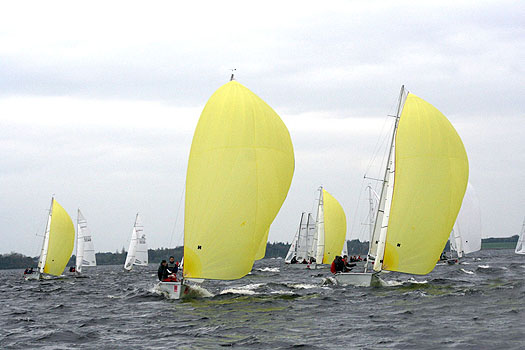
Downwind action in good breeze at the SB3 Midlands on Lough Ree. Photo: Oona Herraghty
Peter Kennedy on Ridgefence will return to defend his title and try to make it a hat trick having won the 2009 and 2010 event on Lough Derg.
The competition is expected to be stiff with Ben Duncan and Brian Moran (Sharkbait) on fire after their National Championships win. Ben also came fourth in last weekend's All Ireland Sailing Championships in Dromineer. A number of the top 10 boats from the Nationals will also be in attendance with Andrew Algeo and Rob Howe both competing.
The event, supported by Galway Maritime, is used to unpredictable weather conditions and over the last few years the fleet has experienced everything from flat calm and blue skies to wet and windy.




























